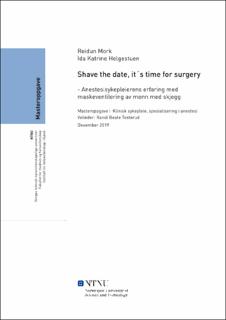| dc.contributor.advisor | Tosterud, Randi Beate | |
| dc.contributor.author | Mork, Reidun | |
| dc.contributor.author | Helgestuen, Ida Katrine | |
| dc.date.accessioned | 2020-06-04T16:05:56Z | |
| dc.date.available | 2020-06-04T16:05:56Z | |
| dc.date.issued | 2019 | |
| dc.identifier.uri | https://hdl.handle.net/11250/2656839 | |
| dc.description.abstract | Introduksjon:
Pasienter med skjegg er et økende fenomen. Mye på grunn av dagens mote og et økende fokus på menns helse. Norge er også med tiden blitt et flerkulturelt land, hvor mange menn har skjegg forankret i sin religion. Pasientsikkerhet står sentralt i sykepleieyrket. En av de viktigste hovedfunksjonene til anestesisykepleiere er å opprettholde frie luftveier, samt overta ventileringen av pasienter under generell anestesi. Maske- baggventilering er førstehåndstiltak og alltid førsteprioritet ved enhver situasjon som krever ventilasjonsstøtte.
Hensikt:
I litteraturen er skjegg en av risikofaktorene som er forbundet med vanskelig maskeventilering. Hensikten med studien er å få frem anestesisykepleieres erfaring når det gjelder maskeventilering til menn med skjegg. Det undersøkes om maskeventilering av menn med skjegg er et problem for anestesisykepleiere, og om det eventuelt tas i bruk enkelte tiltak for å optimalisere maskeventileringen.
Metode:
Metoden til masteroppgaven er kvalitativ med et beskrivende induktiv design. Det ble utført seks individuelle intervjuer ved ett helseforetak. Informantene hadde lang erfaring som anestesisykepleiere. Det ble utviklet en intervjuguide med bakgrunn til studiens hensikt. Innholdet ble analysert ved hjelp av Graneheim og Lundman’s innholdsanalyse. Det ble lagt vekt på det manifeste innholdet i teksten.
Resultat:
Menn med skjegg oppleves som en utfordring for de fleste av informantene. Utfordringen er maskeventilering ved innledning til anestesi. Skjegget hindrer tett maske og fører til inadekvat maskeventilering. Det fremkommer at preoperativ informasjon om skjeggets risiko må prioriteres. Samtidig erfares det at skjegget er en del av identiteten til menn. Dette kan påvirke pasientens handlingsvalg. Det kan dermed oppstå en konflikt mellom pasientens bestemmelsesrett og pasientsikkerheten.
Konklusjon:
Skjegg er en risikofaktor ved maskeventilering. Det ses et behov for forbedring, dette for å optimalisere pasientsikkerheten til pasientgruppen. For at det skal bli endringer i praksis, må problemet løftes opp på systemnivå. Samtidig, vil det være et behov for mer forskning som undersøker tiltak som knyttes til forbedret maskeventilering av menn med skjegg. | |
| dc.description.abstract | Short description of the thesis:
Bearded patients are a growing phenomenon, mostly because of trends and fashion. Norway has also become a multicultural nation, where a beard, for some men, plays a vital part of both religion and culture. The safety of a patient is central to the profession of nursing. One of the most important functions of nurse anesthetists is to maintain free airways and take over the ventilation of patients under general anesthesia. Mask-bag ventilation is a first-aid measure and always first priority in any situation where it is required that the anesthesia takes over the patient's ventilation.
Background:
The purpose of this study is to collect experiences of nurse anesthetists when it comes to mask ventilation of men with beards. We would like to investigate whether mask ventilation of men with beards is a problem for anesthesiologists, and whether any measures has been taken into practice to optimize mask ventilation.
Method:
The method of the master's thesis is qualitative with a descriptive inductive design. We conducted six individual interviews in one health organization. The informants were experienced nurse anesthetists. An interview guide was developed based on the purpose of the study. The content was analyzed by Graneheim and Lundman's content analysis. Emphasis was placed on the manifest content of the text.
Results:
A patient with a beard presents a challenge for most of the informants. The challenge is mask ventilation during the onset of anesthesia. Bag-mask ventilation might be challenging because of the difficulty of achieving a good seal between the mask and the facial hair. This leads to inadequate mask ventilation. It is necessary to prioritize a good preoperative information to inform the patient of the risks of having a beard during induction of general anesthesia. At the same time, the beard is often a part of a man's identity. This can therefore affect the patient's choice of action. Consequently, there may be a conflict between the patient's freedom of choice and the patient's safety.
Conclusion:
The presence of a beard is an important risk factor where mask ventilation is needed. We may need to recommend that the patient shave their beard before the procedure, to optimize patient safety. For changes in practice, this needs to be lifted to system management level. At the same time, there will be a need for more research examining measures related to improved mask ventilation of men with beards. | |
| dc.language | nob | |
| dc.publisher | NTNU | |
| dc.title | Shave the date, it´s time for surgery | |
| dc.type | Master thesis | |
